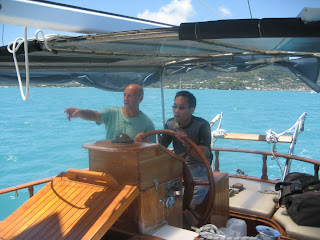

Fraser Island, a UNESCO world heritage site, is the world’s largest sand island. I joined a two day/one night guided tour of the island, as people on self-drive tours frequently get stuck on the soft sand of the island (there are no paved roads on the island).
Fraser Island is amazing, teeming with flora, fauna and scenery. Highlights include Indian Head, a rocky point where one can spot manta rays, sea turtles and pods of sharks. We also visited the Maheno shipwreck, the Pinnacles (colored sandy outcrops) and Eli Creek, which flowed to the ocean.
We went on several rainforest walks and saw eucalyptus, fern and pine trees. We also spotted a giant lizard, huge spiders, a dingo (wild dog) and various birds.
My favorites were the two lakes we visited, Wabby and MacKenzie. Lake Wabby is a green freshwater lake. One can hike up the Hammerstone Sandblow (sand dune) and get a birds-eye view of Lake Wabby. Lake MacKenzie is also a freshwater lake, but with two shades of blue water and white sand. The beach there reminded me of Whitehaven Beach on Whitsunday Island.
Fraser Island is amazing, teeming with flora, fauna and scenery. Highlights include Indian Head, a rocky point where one can spot manta rays, sea turtles and pods of sharks. We also visited the Maheno shipwreck, the Pinnacles (colored sandy outcrops) and Eli Creek, which flowed to the ocean.
We went on several rainforest walks and saw eucalyptus, fern and pine trees. We also spotted a giant lizard, huge spiders, a dingo (wild dog) and various birds.
My favorites were the two lakes we visited, Wabby and MacKenzie. Lake Wabby is a green freshwater lake. One can hike up the Hammerstone Sandblow (sand dune) and get a birds-eye view of Lake Wabby. Lake MacKenzie is also a freshwater lake, but with two shades of blue water and white sand. The beach there reminded me of Whitehaven Beach on Whitsunday Island.











